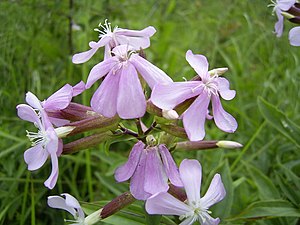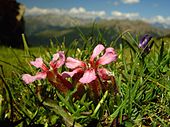Soap herbs
| Soap herbs | ||||||||||||
|---|---|---|---|---|---|---|---|---|---|---|---|---|

Common soapwort ( Saponaria officinalis ) |
||||||||||||
| Systematics | ||||||||||||
|
||||||||||||
| Scientific name | ||||||||||||
| Saponaria | ||||||||||||
| L. |
The soap herbs ( Saponaria ) form a genus of plants within the carnation family (Caryophyllaceae). The approximately 43 species are distributed in temperate Eurasia and North Africa.
The ingredient saponin ( 2 to 5% in the rhizome ) foams like soap in an aqueous solution (root decoction). The common soapwort ( Saponaria officinalis ) was already used in antiquity to wash wool and later also to clean clothes with sensitive colors. Even Hippocrates (* around 460 v. Chr .; † around 370 v. Chr.) Knew this detergent .
description



Vegetative characteristics
The soapwort species are perennial , rarely annual herbaceous plants. The above-ground parts of the plant are bald to more or less hairy with glands.
The leaves are arranged opposite one another. The leaf blades are simple.
Generative characteristics
The flowers are seldom individually, usually in loose or dense, paniculate or heady, zymous inflorescences . The bracts are herbaceous, prophylls are missing. There is a short carpophore .
The mostly hermaphrodite flowers are radially symmetrical and five-fold with a double flower envelope . The five clover leaves have grown together to form a cylindrical calyx. There are no dry-skinned connections at the points of adhesion or they are very narrow. The calyx has 15 to 25 indistinct nerves and ends in five calyx teeth. The five free petals consist of a nail and plate , and throat scales are usually present. There are ten stamens . On the single-chamber ovary there are usually two or rarely three pen .
The capsule fruits usually open with four or rarely six teeth. The seeds are kidney-shaped to almost spherical. The embryo is curved.
Sets of chromosomes
The basic chromosome number is x = 7; the chromosome number 2n = 28 or 56 occurs.



Systematics and distribution
The genus Saponaria was established in 1753 by Carl von Linné in Species Plantarum with diagnosis in Genera Plantarum . The generic name Saponaria is derived from the Latin word sapo for " soap ".
Saponaria species are common in temperate Eurasia , with a focus on the Mediterranean and the Irano-Turanian region.
There are about 43 Saponaria - types :
- Saponaria atocioides Boiss.
- Saponaria bargyliana Gomb. : It occurs in the area of Syria and Lebanon .
- Saponaria bellidifolia Sm . : It occurs on the Balkan Peninsula , in Romania , Italy , France and Spain .
- Saponaria bodeana Boiss.
- Saponaria caespitosa DC. : It occurs only in Spain and France.
- Saponaria calabrica cast. : It occurs only in Italy, the Balkan Peninsula, on the Aegean islands and in Turkey .
- Saponaria cerastoides fish. & CAMey. : It occurs in the Middle East .
- Saponaria chlorifolia (Poir.) Kunze (Syn .: Cyathophylla chlorifolia (Poir.) Bocquet & Strid ): It occurs in Greece and Turkey.
- Saponaria cypria Boiss. : This endemic occurs only in Cyprus .
- Saponaria dalmasii Boiss. : It only occurs in Turkey.
- Saponaria emineana Y.Gemici & Kit Tan : It occurs in Turkey.
- Saponaria glutinosa M.Bieb. : It is common in south and south-east Europe , in North Africa and in Turkey.
- Saponaria griffithiana Boiss. (Syn .: Pleioneura griffithiana (Boiss.) Rech. F. )
- Saponaria gypsacea Vved. : It occurs in Central Asia .
- Saponaria halophila Hedge & Hub.-Mor. : It occurs in Turkey.
- Saponaria intermedia Simmler (Syn .: Saponaria haussknechti Simmler , Saponaria sicula subsp. Intermedia (Simmler) Chater ): It occurs on the Balkan Peninsula.
- Saponaria iranica Dashti, Assadi & Sharifnia : It occurs in Iran.
- Saponaria jagelii Phitos & Greuter : It occurs only in Greece.
- Saponaria karapinarensis Vural & N.Adıgüzel : It occurs in Turkey.
- Saponaria kermanensis Bornm. : It occurs in Iran.
- Saponaria kotschyi Boiss. : It occurs in Turkey.
- Yellow soapwort ( Saponaria lutea L. ): It is found in France, Italy and Switzerland .
- Saponaria mesogitana Boiss. : It occurs in Palestine and Turkey.
- Red soapwort , red soapwort ( Saponaria ocymoides L. )
- Common soapwort ( Saponaria officinalis L. )
- Saponaria orientalis L .: It occurs in Southwest Asia .
- Saponaria pachyphylla Rech. F. : It occurs in Afghanistan and Pakistan .
- Saponaria pamphylica Boiss. & Hero. : It occurs in Turkey.
- Saponaria picta Boiss. : It occurs in Turkey.
- Saponaria pinetorum Hedge : It occurs in Turkey.
- Saponaria prostrata Willd. : It occurs in Turkey.
- Dwarf soapwort ( Saponaria pumila Janch. , Syn .: Saponaria pumilio (L.) A. Braun non Boiss. ): It occurs only in Austria, Italy and Romania.
- Saponaria pumilio Boiss. (Syn .: Saponaria pulvinaris Boiss. ): It occurs in the Middle East.
- Saponaria sicula Raf. : It occurs on the Balkan Peninsula, in Algeria , in Sardinia and Sicily .
- Saponaria spathulifolia ( Fenzl ) Vved. : It occurs in Central Asia.
- Saponaria stenopetala Rech. F. : It occurs in Afghanistan.
- Saponaria stranjensis Jordanov : It occurs only in Bulgaria .
- Saponaria subrosularis Rech. F. : It occurs in Pakistan.
- Saponaria suffruticosa Nábělek : It occurs in Turkey and Iraq .
- Saponaria syriaca Boiss. : It occurs in Turkey.
- Saponaria tridentata Boiss. : It occurs in the Middle East.
- Saponaria viscosa C.A.Mey. : It occurs in Armenia and Iran.
Hybrids:
- Saponaria × lempergii Wocke ( Saponaria cypria × Saponaria haussknechti )
- Saponaria × olivana Wocke ( Saponaria caespitosa × Saponaria pumila )
- Saponaria × wiemanni Fritsch ( Saponaria caespitosa × Saponaria lutea )
The following is no longer included in the genus Saponaria :
- Gypsophila floribunda (Kar. & Kir.) Turcz. ex Ledeb. (Syn .: Saponaria floribunda (Kar. & Kir.) Boiss. , Psammophiliella floribunda (Kar. & Kir.) Ikonn. )
- Gypsophila makranica (Rech. F.) Ghaz. (Syn.: Saponaria makranica Rech.f. )
swell
literature
- Manfred A. Fischer, Wolfgang Adler, Karl Oswald: Excursion flora for Austria, Liechtenstein and South Tyrol . 2nd, improved and enlarged edition. Province of Upper Austria, Biology Center of the Upper Austrian State Museums, Linz 2005, ISBN 3-85474-140-5 , p. 341 .
- Ruprecht Düll , Herfried Kutzelnigg : Pocket dictionary of plants in Germany. A botanical-ecological excursion companion to the most important species . 6th, completely revised edition. Quelle & Meyer, Wiebelsheim 2005, ISBN 3-494-01397-7 , p. 424 .
- Siegmund Seybold (Ed.): Schmeil-Fitschen interactive . CD-ROM, version 1.1. Quelle & Meyer, Wiebelsheim 2002, ISBN 3-494-01327-6 .
Individual evidence
- ↑ a b c d e f Volker Bittrich: Caryophyllaceae. In: Klaus Kubitzki, Jens G. Rohwer, Volker Bittrich (Eds.): The Families and Genera of Vascular Plants . Volume 2: Flowering Plants. Dicotyledons. Magnoliid, Hamamelid and Caryophyllid Families . Springer, Berlin / Heidelberg / New York 1993, ISBN 3-540-55509-9 , pp. 231 (English, limited preview in Google Book search).
- ↑ a b c Shahina A. Ghazanfar: Flora of Pakistan 175: Caryophyllaceae. Department of Botany, University of Karachi, Karachi 1986, Saponaria p. 100, HTML version at efloras.org.
- ↑ Carl von Linné: Species Plantarum. Volume 1, Lars Salvius, Stockholm 1753, p. 408, digitized
- ↑ Carl von Linné: Genera plantarum: eorumque characteres naturales secundum numerum, figuram, situm, et proportionem omnium fructificationis partium. Editio quinta. Lars Salvius, Stockholm 1754, p. 191, digitized
- ↑ a b c d e f g h i j k l m n o p q r s t u v w x y z aa ab ac ad ae Karol Marhold: Caryophyllaceae. Saponaria. - Datasheet In: Euro + Med Plantbase - the information resource for Euro-Mediterranean plant diversity. Berlin 2011.
- ↑ a b c d e f g h i j k Karl Heinz Rechinger: Saponaria. In: Karl Heinz Rechinger, Volker Melzheimer, W. Möschl, H. Schimann-Czeika: Flora Iranica. Flora of the Iranian highlands and the surrounding mountains. No. 163. Caryophyllaceae II - Alsinoideae et Silenoideae. Akademische Druck- und Verlagsanstalt, Graz 1988, pp. 196–205.
- ↑ Yusuf Gemici, Kit Tan, Hasan Yıldırım, AF Pirhan: Saponaria emineana (Caryophyllaceae), a new species from inner Anatolia, Turkey. In: Phytotaxa. Volume 30, 2011, pp. 45-52 (PDF file) .
- ↑ a b Sergej Kirillovich Czerepanov: Vascular plants of Russia and adjacent states (the former USSR). Cambridge University Press, Cambridge u. a. 1995, ISBN 0-521-45006-3 , pp. 172-173.
- ↑ Alemeh Dashti, Mostafa Assadi, Fariba Sharifinia: A new species of the genus Saponaria L. (Caryophyllaceae) in Iran. In: Iranian Journal of Botany. Volume 20, No. 2, 2014, pp. 146–151 (PDF file) ( Memento of the original from September 1, 2015 in the Internet Archive ) Info: The archive link was inserted automatically and has not yet been checked. Please check the original and archive link according to the instructions and then remove this notice. .
- ↑ Mecit Vural, Hayri Duman, Zeki Aytaç, Nezahat Adıgüzel: Saponaria karapinarensis, Senecio salsuginea and Centaurea tuzgoluensis, three new species from central Anatolia, Turkey. In: Belgian Journal of Botany. Volume 139, No. 2, 2006, 252-260, JSTOR 20794613 .
- ^ Ali A. Dönmez: Saponaria suffruticosa (Caryophyllaceae): An enigmatic species from south-west Asia on the border of Turkey and Iraq. In: Hacettepe Journal of Biology. Volume 37, No. 3, 2009, pp. 181–187 (PDF file) ( Memento of the original from October 29, 2013 in the Internet Archive ) Info: The archive link has been inserted automatically and has not yet been checked. Please check the original and archive link according to the instructions and then remove this notice. .
- ↑ Gudrun Simmler: Monograph of the genus Saponaria. In: Memoranda of the Imperial Academy of Sciences, Mathematical and Natural Science Class, Vienna. Volume 85, 1910, pp. 433-509, digitized .
- ↑ a b Shahina Ghazanfar, Yasin J. Nasir: Flora of Pakistan 175: Caryophyllaceae. Department of Botany, University of Karachi, Karachi 1986, Gypsophila pp. 89-99 (on- line ).
- ^ Lu Dequan, Nicholas J. Turland: Gypsophila. In: Wu Zhengyi, Peter H. Raven, Deyuan Hong (Eds.): Flora of China . Volume 6: Caryophyllaceae through Lardizabalaceae . Science Press / Missouri Botanical Garden Press, Beijing / St. Louis 2001, ISBN 1-930723-05-9 , pp. 108 (English, PDF file - online ).





